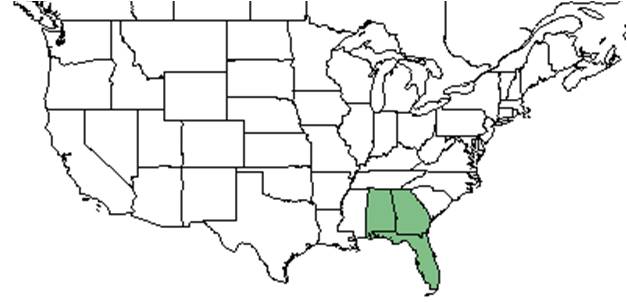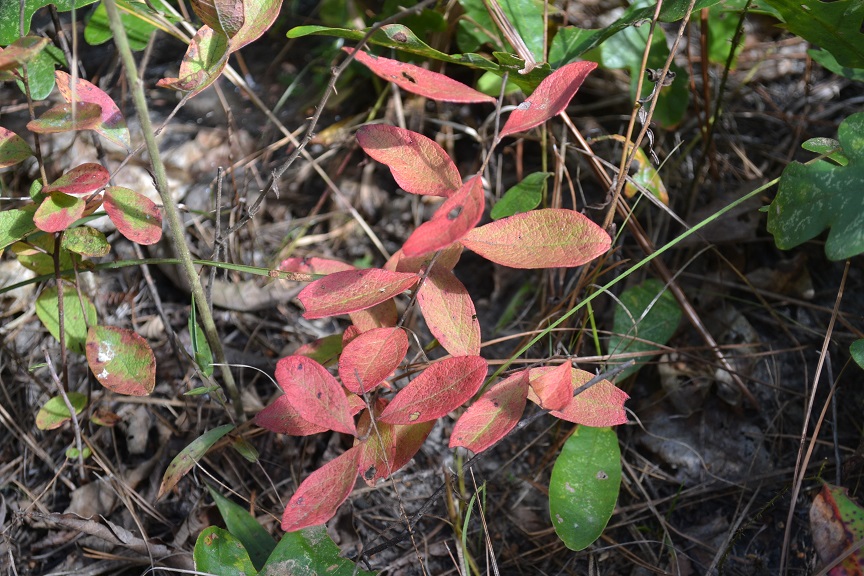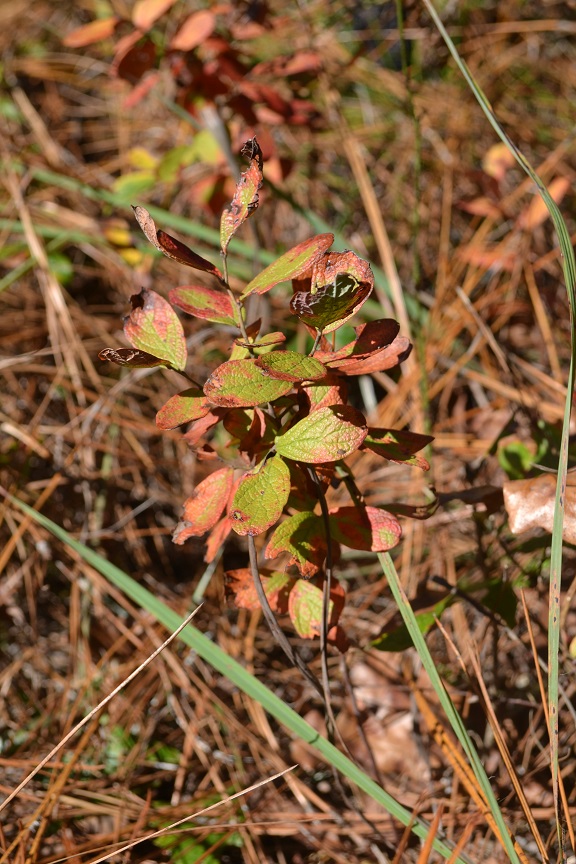Difference between revisions of "Gaylussacia nana"
Laurenloria (talk | contribs) |
|||
| (21 intermediate revisions by 6 users not shown) | |||
| Line 1: | Line 1: | ||
{{italic title}} | {{italic title}} | ||
<!-- Get the taxonomy information from the NRCS Plants database --> | <!-- Get the taxonomy information from the NRCS Plants database --> | ||
| − | Common name: | + | Common name: confederate huckleberry, dwarf dangleberry<ref name=weakley>Weakley, A.S. 2020. Flora of the Southeastern United States. Edition of 20 October 2020. University of North Carolina at Chapel Hill, Chapel Hill, North Carolina.</ref> |
{{taxobox | {{taxobox | ||
| name = Gaylussacia nana | | name = Gaylussacia nana | ||
| Line 19: | Line 19: | ||
}} | }} | ||
==Taxonomic notes== | ==Taxonomic notes== | ||
| − | Synonyms: ''Gaylussacia frondosa'' (Linnaeus) Torrey & A. Gray ex Torrey var. ''nana'' A. Gray | + | Synonyms: ''Decachaena nana'' (A. Gray) Small; ''Gaylussacia frondosa'' (Linnaeus) Torrey & A. Gray ex Torrey var. ''nana'' A. Gray<ref name=weakley>Weakley, A.S. 2020. Flora of the Southeastern United States. Edition of 20 October 2020. University of North Carolina at Chapel Hill, Chapel Hill, North Carolina.</ref> |
| + | |||
| + | Varieties: none<ref name=weakley/> | ||
| + | |||
| + | ==Description== <!-- Basic life history facts such as annual/perrenial, monoecious/dioecious, root morphology, seed type, etc. --> | ||
| + | ''Gaylussacia nana'', also known as confederate huckleberry, is a perennial shrub that is a member of the Ericaceae family.<ref name= "USDA">USDA, NRCS. (2016). The PLANTS Database (http://plants.usda.gov, 17 May 2019). National Plant Data Team, Greensboro, NC 27401-4901 USA.</ref> It is differentiated from ''G. frondosa'' by its glacous foliage and rugose and smaller leaves. As well, it is unique with its unusual underground stems.<ref>Small, J. K. (1897). "Shrubs and trees of the southern states. -II." Bulletin of the Torrey Botanical Club 24(9): 437-445.</ref> | ||
| − | |||
| − | |||
==Distribution== | ==Distribution== | ||
| + | This species is generally restricted to the states of Florida, Georgia, and Alabama in the southeastern United States.<ref name= "USDA"/> It is more specifically distributed within the southeast coastal plain from southeast South Carolina south to northern and central peninsular Florida, the Florida panhandle, west to eastern Louisiana, and disjunct in southeastern North Carolina.<ref name=weakley/> | ||
| + | |||
==Ecology== | ==Ecology== | ||
| − | + | ===Habitat=== <!--Natural communities, human disturbed habitats, topography, hydrology, soils, light, fire regime requirements for removal of competition, etc.--> | |
| + | This species is commonly found in xeric sandhills in its native distribution.<ref name=weakley/> It has been observed to grow in pine-scrub oak woodlands, open pinewoods and longleaf pinewoods, bordering a depression pond, boggy pine flatwoods, on mid-slopes of a ravine, a wet seepage bog, and other sandhill habitats. Soils it has been observed in include loamy sand, drying sand, and boggy soil.<ref name= "herbarium">Florida State University Robert K. Godfrey Herbarium database. URL: http://herbarium.bio.fsu.edu. Last accessed: May 2019. Collectors: Loran C. Anderson, Robert K. Godfrey, Mike Jenkins, Lisa Keppner, R. Komarek, William Platt, and Annie Schmidt. States and Counties: Florida: Franklin, Jefferson, Leon, Liberty, Okaloosa, Wakulla, and Washington. Georgia: Thomas.</ref> It is a characteristic species of the upper panhandle savannas in Florida, being one of the more prevalent woody species in the habitat.<ref>Carr, S. C., et al. (2010). "A Vegetation Classification of Fire-Dependent Pinelands of Florida." Castanea 75(2): 153-189.</ref> At the Wade Tract preserve located in Arcadia Plantation near Thomasville Georgia, ''G. nana'' is an upland and mid-slope species within the longleaf pine savannas.<ref>Gilliam, F. S., et al. (2006). "Natural disturbances and the physiognomy of pine savannas: A phenomenological model." Applied Vegetation Science 9: 83-96.</ref> | ||
| + | |||
| + | Associated species includes ''Gaylussacia mosieri'', ''Kalmia latifolia'', ''Vaccinium darrowii'', ''Sorghastrum elliottii'', ''Quercus pumila'', ''Pinus palustris'', ''Pinus clausa'', ''Sarracenia leucophylla'', ''Calopogon barbatus'', ''Drosera'' sp., and others.<ref name= "herbarium"/> | ||
| + | |||
===Phenology=== <!--Timing off flowering, fruiting, seed dispersal, and environmental triggers. Cite PanFlora website if appropriate: http://www.gilnelson.com/PanFlora/ --> | ===Phenology=== <!--Timing off flowering, fruiting, seed dispersal, and environmental triggers. Cite PanFlora website if appropriate: http://www.gilnelson.com/PanFlora/ --> | ||
| − | + | ''G. nana'' has been observed to flower from March to May with peak inflorescence in April.<ref>Nelson, G. [http://www.gilnelson.com/ PanFlora]: Plant data for the eastern United States with emphasis on the Southeastern Coastal Plains, Florida, and the Florida Panhandle. www.gilnelson.com/PanFlora/ Accessed: 9 DEC 2016</ref> It has also been observed flowering in January, and has been observed fruiting in January, and April through June.<ref name= "herbarium"/> | |
<!--===Seed dispersal===--> | <!--===Seed dispersal===--> | ||
<!--===Seed bank and germination===--> | <!--===Seed bank and germination===--> | ||
| − | + | ||
| + | ===Fire ecology=== <!--Fire tolerance, fire dependence, adaptive fire responses--> | ||
| + | Populations of '' Gaylussacia nana'' have been known to persist through repeated annual burning.<ref>Robertson, K.M. Unpublished data collected from Pebble Hill Fire Plots, Pebble Hill Plantation, Thomasville, Georgia.</ref> It grows in habitats that are frequently burned, where it has been collected from sites that were recently burned in longleaf pine savannas.<ref name= "herbarium"/> | ||
<!--===Pollination===--> | <!--===Pollination===--> | ||
| − | <!--=== | + | <!--===Herbivory and toxicology===--> |
<!--===Diseases and parasites===--> | <!--===Diseases and parasites===--> | ||
| − | |||
| − | == | + | ==Conservation, cultivation, and restoration== |
| + | On the global scale, ''G. nana'' is listed as a G4 status due to its restricted distribution. It is also considered imperiled in Mississippi and critically imperiled in North Carolina.<ref>[[http://explorer.natureserve.org]] NatureServe Explorer. Accessed: May 17, 2019</ref> | ||
| + | |||
| + | ==Cultural use== | ||
==Photo Gallery== | ==Photo Gallery== | ||
<gallery widths=180px> | <gallery widths=180px> | ||
Latest revision as of 14:37, 26 May 2023
Common name: confederate huckleberry, dwarf dangleberry[1]
| Gaylussacia nana | |
|---|---|

| |
| Photo taken by Kevin Robertson | |
| Scientific classification | |
| Kingdom: | Plantae |
| Division: | Magnoliophyta - Flowering plants |
| Class: | Magnoliopsida - Dicotyledons |
| Order: | Ericales |
| Family: | Ericaceae |
| Genus: | Gaylussacia |
| Species: | G. nana |
| Binomial name | |
| Gaylussacia nana (A. Gray) Small | |

| |
| Natural range of Gaylussacia nana from USDA NRCS Plants Database. | |
Contents
Taxonomic notes
Synonyms: Decachaena nana (A. Gray) Small; Gaylussacia frondosa (Linnaeus) Torrey & A. Gray ex Torrey var. nana A. Gray[1]
Varieties: none[1]
Description
Gaylussacia nana, also known as confederate huckleberry, is a perennial shrub that is a member of the Ericaceae family.[2] It is differentiated from G. frondosa by its glacous foliage and rugose and smaller leaves. As well, it is unique with its unusual underground stems.[3]
Distribution
This species is generally restricted to the states of Florida, Georgia, and Alabama in the southeastern United States.[2] It is more specifically distributed within the southeast coastal plain from southeast South Carolina south to northern and central peninsular Florida, the Florida panhandle, west to eastern Louisiana, and disjunct in southeastern North Carolina.[1]
Ecology
Habitat
This species is commonly found in xeric sandhills in its native distribution.[1] It has been observed to grow in pine-scrub oak woodlands, open pinewoods and longleaf pinewoods, bordering a depression pond, boggy pine flatwoods, on mid-slopes of a ravine, a wet seepage bog, and other sandhill habitats. Soils it has been observed in include loamy sand, drying sand, and boggy soil.[4] It is a characteristic species of the upper panhandle savannas in Florida, being one of the more prevalent woody species in the habitat.[5] At the Wade Tract preserve located in Arcadia Plantation near Thomasville Georgia, G. nana is an upland and mid-slope species within the longleaf pine savannas.[6]
Associated species includes Gaylussacia mosieri, Kalmia latifolia, Vaccinium darrowii, Sorghastrum elliottii, Quercus pumila, Pinus palustris, Pinus clausa, Sarracenia leucophylla, Calopogon barbatus, Drosera sp., and others.[4]
Phenology
G. nana has been observed to flower from March to May with peak inflorescence in April.[7] It has also been observed flowering in January, and has been observed fruiting in January, and April through June.[4]
Fire ecology
Populations of Gaylussacia nana have been known to persist through repeated annual burning.[8] It grows in habitats that are frequently burned, where it has been collected from sites that were recently burned in longleaf pine savannas.[4]
Conservation, cultivation, and restoration
On the global scale, G. nana is listed as a G4 status due to its restricted distribution. It is also considered imperiled in Mississippi and critically imperiled in North Carolina.[9]
Cultural use
Photo Gallery
References and notes
- ↑ 1.0 1.1 1.2 1.3 1.4 Weakley, A.S. 2020. Flora of the Southeastern United States. Edition of 20 October 2020. University of North Carolina at Chapel Hill, Chapel Hill, North Carolina.
- ↑ 2.0 2.1 USDA, NRCS. (2016). The PLANTS Database (http://plants.usda.gov, 17 May 2019). National Plant Data Team, Greensboro, NC 27401-4901 USA.
- ↑ Small, J. K. (1897). "Shrubs and trees of the southern states. -II." Bulletin of the Torrey Botanical Club 24(9): 437-445.
- ↑ 4.0 4.1 4.2 4.3 Florida State University Robert K. Godfrey Herbarium database. URL: http://herbarium.bio.fsu.edu. Last accessed: May 2019. Collectors: Loran C. Anderson, Robert K. Godfrey, Mike Jenkins, Lisa Keppner, R. Komarek, William Platt, and Annie Schmidt. States and Counties: Florida: Franklin, Jefferson, Leon, Liberty, Okaloosa, Wakulla, and Washington. Georgia: Thomas.
- ↑ Carr, S. C., et al. (2010). "A Vegetation Classification of Fire-Dependent Pinelands of Florida." Castanea 75(2): 153-189.
- ↑ Gilliam, F. S., et al. (2006). "Natural disturbances and the physiognomy of pine savannas: A phenomenological model." Applied Vegetation Science 9: 83-96.
- ↑ Nelson, G. PanFlora: Plant data for the eastern United States with emphasis on the Southeastern Coastal Plains, Florida, and the Florida Panhandle. www.gilnelson.com/PanFlora/ Accessed: 9 DEC 2016
- ↑ Robertson, K.M. Unpublished data collected from Pebble Hill Fire Plots, Pebble Hill Plantation, Thomasville, Georgia.
- ↑ [[1]] NatureServe Explorer. Accessed: May 17, 2019

